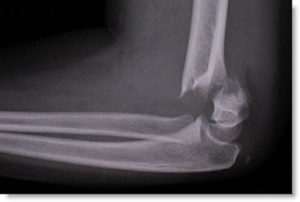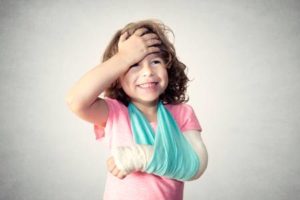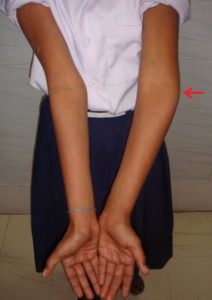
Source: www.pemcincinnati.com
School holiday is almost over. The holiday season is a significant season for us, working at the Department of Orthopaedics. Every year, during this season, without fail, the Orthopaedic Ward will be filled with paediatric patients hospitalised due to arm fractures (broken arm), also known as Supracondylar Humerus Fracture.
This situation often occurs when children fall to the ground while having fun playing, especially when climbing the ‘monkey bars’ at the playground or tall trees within the house compound. Usually, the children fall to the ground with their elbows facing straight forward and their palms pressed to the ground, to avoid their face or head from injury. This fall mechanism is known as Fall on Out-Stretched Hand or its acronym, FOOSH.
This will cause arm fractures situated at the upper part of their elbows. They usually come to the emergency unit in a state of pain, with their elbows swelling and sometimes, bent as a result of trauma. In serious cases, these fractures can cause injury to the nerves in the arms, namely the Medianand Ulnar Nerve, or pressure on the main blood vessels, brachial artery, which can lead to tissue death of the patient’s hand or gangrene.
If a child falls and complains of pain, or their elbow looks swollen and bent, take them to the hospital immediately for a further examination. This is important to rule out bone fractures.
Types of Fractures
Basically, Supracondylar fracture of humerus can be divided into three types:
- Type I – A fracture occurs but the bone does not move (non-displaced fracture)
- Type II – A fracture occurs, however, part of the arm bone (posterior cortex) is not completely broken
- Type III- A fracture occurs and the bone moves (completely displaced fracture)
 Treatment
Treatment
The treatment provided for the children depends on the level of their fractures.
The first step begins with admission to the Orthopaedic Ward for observation of injuries; especially in the blood vessels and the nerves of the arm involved. This step is important to ensure that the children do not move the broken parts to avoid the bone from continuing to move. In addition, the blood circulation and the oxygen saturation will be recorded at the affected fingers’ tips. To reduce swelling, we will raise the level of their hands and add ice.
Next, backslab, a type of cement called ‘Plaster of Paris’, shall be cast to your child’s arm to prevent the fractures from moving. Should the bones move, we may need to apply tractionto reduce the bone bentness and your child’s pain.
For the first type of the bone fracture’s treatment, the cement cast from the top of the elbow to the hand’s area is considered sufficient. There is no surgery required. X-ray procedure will be performed after the cement had been cast in ensuring that the bone does not move.
For the second and the third type of bone fracture, a traction procedure called Closed Manipulative Reduction (CMR) will be performed. If the traction procedure fails, this procedure will be performed in an operation theatre using a special camera known as Image Intensifier or I/I. The fracture on your child’s arm will be fixed to the original position and held with a stainless steel wire. After the stainless steel wire is placed, the bone’s position is then re-examined using the I/I machine.
It requires a certain traction technique in ensuring your child’s arm bone is in the right position as per before. If this procedure fails, a surgery will be performed. Your child will be given full anaesthetic during the procedure.
 The Recovery Process
The Recovery Process
The patient is usually allowed to return home, two days after the procedure, or after the surgery had been performed. X-ray procedure will be performed in ensuring the fracture and the wire are in the correct position. After three weeks, the wire will be pulled out since, during that time, the new bones or soft calluses start to form, and unite with their counterparts. It is important for the parents to encourage their children to undergo physiotherapy treatment to regain normal movement of their elbows’ joints. The fracture will heal within six to eight weeks.
A sincere advice from me, please come quickly to the hospital to get treatment for these fractures. Forget about your intention to consult traditional healers (bomoh) or seek traditional treatment since inaccurate treatments of the fractures will cause major problems in the future. Your child’s arm may be deformed and bent like a gun, a condition called as ‘gun stock deformity’. This can occur if the treatment of Supracondylar humerusfracture procedure is not performed correctly and causes inaccurate bone union. Should this occur, we need to perform major surgery, by breaking the bent bones to correct the position of the bone to its original position. The movement of the elbow and the bone reunion after the surgery is not comparable with the results of early treatment.
This article was written by the Malaysian Medical Gazette advisor, Dr Mahyuddin, an orthopaedic surgeon working at a hospital in Pahang. Get acquainted with him at The Team page.
References:
- Reza Omid, Paul D. Choi and David L. Skaggs. Supracondylar Humeral fracture in Children. J Bone Joint Surg Am. 2008;90:1121-1132.
- Mininder S. Kocher, James R. Kasser, Peter M. Waters, Donald Bae, Brian D. Snyder, M. Timothy Hresko, Daniel Hedequist, Lawrence Karlin, Young-Jo Kim, Martha M. Murray, Michael B. Millis, John B. Emans, Laura Dichtel, Travis Matheney and Ben M. Lee. Lateral Entry Compared with Medial and Lateral Entry Pin Fixation for Completely Displaced Supracondylar Humeral Fractures in Children. A Randomized Clinical Trial. J Bone Joint Surg Am. 2007;89:706-712
This article was translated by Nurul Aini Ahmad from https://www.mmgazette.com/patah-tulang-lengan-dr-ahmad-mahyuddin/.
[This article belongs to The Malaysian Medical Gazette. Any republication (online or offline) without written permission from The Malaysian Medical Gazette is prohibited.]
